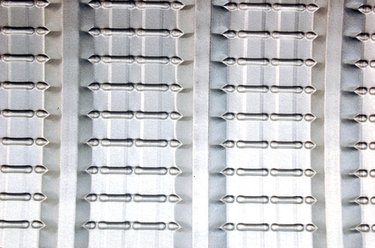
Sheet metal is nothing more than metal that has been pressed into sheets. Sheet metal is used in products such as roofs and electronics. Various operations are carried out so that the sheet metal can be morphed into forms that can be used in various products. These operations are usually carried out with automated machinery at manufacturing plants. The operations that are chosen for different tasks depend on the tasks themselves and the capabilities of the manufacturing equipment.
Bending
Video of the Day
Bending is when sheet metal is taken and bent to a predetermined angle. The bending operation creates a straight line bend and the form operation creates a curved bend. Sheet metal is sometimes arranged with joints, according to Scribd. The types of joints include the flush joint, which must have one sheet that is level, the edge over joint, which is used when fixing the bottoms of objects, grooved joints, where one edge is folded down and one is folded up and double grooved joints.
Video of the Day
Die Manufacturing
Die manufacturing is used to cut a variety of kinds of sheet metal into the shapes that they need to be in. The cutting is performed using a special tool called a die. This technique is used to create objects such as paperclips. The die cutting involves perforation, the shearing of the sheet into two and removing sheet metal piece edges, according to Slide Share, according to Scribd.
Ironing
Ironing is the use of force to reduce the thickness of the sheet metal. The sheet metal becomes more dense but also becomes thinner, which is beneficial in some circumstances, according to Scribd.
Cutting, Slotting and Blanking
Cutting is the act of separating two pieces of sheet metal so that the pieces of sheet metal can be used in the manufacturing of a product. Cutting can come in different forms such as slotting, perforating and shaving. Slotting is the act of punching holes into the sheet metal for various manufacturing processes, perforating is the punching of patterns into the sheet metal, notching is the removal and trimming of the edge portion of the sheet metal and shaving and fine blanking are the smoothing out of the edges of the sheet metal, according to Slide Share. Blanking is the enlarging of a previously made hole in the sheet metal.
Slitting
Sheet metal is sometimes cut into two pieces through a process called slitting. Slitting is done with a rolling part that has a shearing blade which cuts the sheet metal straight down the middle, according to Slide Share.
Nibbling
In the nibbling process, the sheet metal is sent through the nibbler, which punches overlapping holes in the sheet metal.